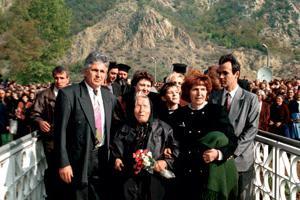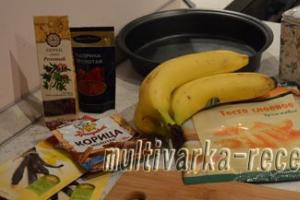Each people of the world has its own characteristics, which are absolutely normal and ordinary for them, but if a person of another nationality falls into their midst, he may be very surprised by the habits and traditions of the inhabitants of this country, because they will not coincide with his own ideas about life. We invite you to find out 9 national habits and characteristics of Hungarians that may seem surprising and a little strange to Russian people.
They eat paprika always and everywhere
Paprika is an integral part of the Hungarian national cuisine. This spice (powder of dried mildly hot pepper) is added everywhere, but especially in goulash - another culinary treasure of the nation. Paprika is sold in bags in markets and as a souvenir for foreigners. The number of its varieties amounts to a dozen varieties, and the tree, strewn with small red fruits, grows in the garden or on the windowsill of almost every Hungarian.
They don't drink tea

Accompanying any dessert with tea, which is customary for Russians, does not work in Hungary. With all the richness of flour pastries and national sweets, Hungarians prefer to wash down their dishes with plain water or coffee. Here tea is meant rather as a remedy for illnesses. (By the way, very similar to the Bulgarians. Indeed, why drink tea if excellent freshly brewed coffee is sold everywhere for €1?
They go to the baths en masse

The thermal baths of Budapest are a world-famous attraction. In outdoor pools it is customary not to swim, but to sit. The water temperature varies from 16 to 42 °C. Daredevils prefer contrasting transitions from hot to cold, pensioners sit under hydromassage, children frolic in warm “paddling pools”. The Hungarians themselves go to the bathhouse not so much to wash themselves or improve their health, but rather to relieve stress. Yes, healing properties Thermal water does have a beneficial effect on the skin and joints, but for Hungarians it is primarily a great reason to spend time with family on the weekend.
They're not afraid of the homeless

There are a lot of people without a fixed place of residence in Budapest. They are literally everywhere: begging, sleeping, eating, communicating with each other. They are kicked out only from the most central and tourist places of the city. Representatives of the foot patrol do this as politely and delicately as possible. This lifestyle is associated not only with economic situation in the country, but also with the nomadic nature of a certain layer of society. Don't work and live on the street - conscious choice many. They are clean, take care of themselves, and for the most part are no different from ordinary passers-by. Unless they live in tents, wash things in the waters of the Danube or in a street pump and dry them right there on the branches of trees.
They are very patriotic

A sense of pride in one’s history and the unity of the nation is in the blood of every Hungarian. In Budapest, on Heroes' Square, the central part is occupied by the Memorial to the 1000th Anniversary of the Finding of the Motherland, founded in 1896. Throughout the second half of the 9th century, the ancestors of the current Magyars moved from the Trans-Urals to the Danube Valley. And to this day, Hungarians protect their language from foreign influences. They are generally quite active citizens: on city streets there are posters everywhere with calls to influence everyday corruption, actively vote in elections, and take part in the political situation of the country. If something goes wrong, they feel a responsibility to change it. Here it is not customary to be ashamed of one’s origins, and in case of career success, a Hungarian often attributes it to his ancestry.
They spoil the children

Here and there you can hear everywhere: “Mit seretne?”, which translated means “what would you like?” The child’s opinion is respected from childhood and the upbringing process is treated with exceptional care. For Hungarians, children are not people, but little deities who can do anything. Of course, this affects the kids, but surprisingly they grow up not to be spoiled egoists, but to be open, smiling, kind and not at all shy about strangers. Each child, according to his parent, needs his own individual pace of development. For example, staying a second year is not considered humiliating here.
They don't walk around without documents

Firstly, police in Hungary can simply and completely legally check the documents of any pedestrian on the street. Secondly, a travel ticket here can only be purchased with an ID card. In this case, the authorities are guided by simple logic: only one citizen of the country can travel with one license, and not all members of his family. Tourists buy a long-term travel ticket using a passport or a one-time pass without proof of identity. And finally, no one has canceled the procedure for confirming your age when purchasing alcohol in bars.
They are alien to ceremony

Hungarians address each other as "you". Everything and always. The only exception is when addressing older people in order to emphasize respect for a specific person. After the greeting there is an obligatory kiss: first they kiss on one cheek, then on the other.
They celebrate name days

Don't be surprised if no one wishes you a happy birthday. This holiday is not usually celebrated here in the usual sense for us. A much more important day for a Hungarian is name day. On name days, as on any serious celebration in Hungary, a noisy feast is organized and gifts are given.
On my excursions the question often comes up: Is it true that Russians are not liked here? True and false at the same time. Taking a look at all the revolutions and wars of liberation that the Hungarians organized once a century in an attempt to achieve freedom and independence, I will say that the Hungarians have reason not to love the Russians, because many of these wars and revolutions were suppressed with the help of the Russian army (for example, the war of 1703 -1711, anti-Habsburg uprising of 1848-49). It seems to me that very few people like Russians in general, but let’s be honest, no one is obliged to. It’s clear that in the 21st century no one will remember the 18th century; these are things of “past days” and now Hungarians are very loyal to tourists, including Russian tourists. My dear friend Anna Chernova, a journalist for the British information portal Zima, recently wrote a review entitled “What are the British like?” I read her article with pleasure and thought: what are they like, Hungarians?
Thanks to my dear orchestra, I traveled a lot and realized something important for me: people are the same everywhere. There are adequate ones, and there are inadequate ones. There are those who are successful and those who are suffering. It is incredibly difficult for me to draw any conclusions about the Hungarians, because I understand that as much as I love Hungary, I do not understand the Hungarians. I do not expect my point of view to be accepted in this matter, while I hope that I will not offend anyone with this article; in all subsequent cases of using the word “Hungarians,” my opinion is based on personal experience (and maybe a little on stereotypes).
A little negative
Hungarians are quite strange guys. They like to live in the past, they like to remember how they were offended (first the countries that won the First World War took away 2/3 of the territory, and then the USSR offended them for 45 years after the Second World War), they like not to remember when they they were offended (in Budapest before WWII there was the largest community of Jews, three-quarters of whom did not survive the war). Hungarians love to suffer and say that they are tired (working from Monday to Friday 8 hours a day). One of the first attempts to joke in Hungarian was “Haha, I’m Hungarian now too, because I’m very tired.” (a couple of people found it funny, so humor was counted). Hungarians are very pessimistic; in the 19th and 20th centuries, many artists committed suicide.
In a group of Russian-speaking residents of Budapest, this question also recently “came up” and there was something to smile about in the comments. Among the “unobligatory”, “unreliable”, “not hardworking” ones, “those looking for profit in everything” and “tend to steal everything that is bad” were also identified. Hungarians don't like Hungarians. Hungarians don't like to plan. Hungarian men are not eager to provide for their women. The characters of Hungarian men and Hungarian women are reversed. For a relationship to reach marriage, women here wait at least 5-8 years. Sometimes men are so incapable of making a decision that you simply wonder: how can anyone be in a relationship with him?
A little positivity
I believe that we ourselves build our social circle, so all of the above are stereotypes. What I saw from personal experience it was more positive. Hungarians are excellent fathers, thanks to their gentleness, amenability, and good nature. The Hungarians I met were quite open minded. Older men are very gallant and educated. Hungarian humor is so subtle that I still can’t always understand it due to language barriers. But when I understand, I laugh until I cry. The rule of 6 handshakes in Hungary comes down to 2-3, everyone knows each other. One of the most touching stories for me was when I was talking with my friend David about the band Subscribe, which I have loved for a very long time, and it turned out that the guitarist of the group was actually David’s classmate! Hungarians are quite conservative and love their rights (the most important thing is that they know them). Hungarians love to talk. On one of my first trips, when I could already speak Hungarian quite well, I stopped being frightened by sudden dialogues while standing in line at the store. One girl on Facebook described this moment very accurately: “it’s okay to just turn to to a stranger and say: wow, it’s hot, huh”:)
To summarize, I always say: “Well, in general, something like this. Hungarians are strange guys.” This characteristic describes them perfectly. Strange.
Original taken from oper_1974 to Magyars. (55 photos)
For 1941 - 1943 In Chernigov and surrounding villages alone, Hungarian troops took part in the extermination of 59,749 Soviet citizens.
And here are the testimonies of peasants living in the Sevsk region:
“Fascist accomplices of the Magyars entered our village Svetlovo 9/V-42,” said peasant Anton Ivanovich Krutukhin. “All the residents of our village hid from such a pack and they are a sign that the residents began to hide from them, and those who were unable to hide , neither they were shot nor raped by several of our women.
I myself, an old man born in 1875, was also forced to hide in the cellar... There was shooting all over the village, buildings were burning, and Magyar soldiers were robbing our things, stealing cows and calves."

On May 20, about 700 Hungarian soldiers headed from Orlia to nearby villages. On the collective farm "4th Bolshevik Sev" they arrested all the men.
“When they saw the men of our village, they said that they were partisans,” said Varvara Fedorovna Mazerkova. “And on the same date, i.e. 20/V-42, they captured my husband Mazekov Sidor Borisovich born in 1862 and my son Mazekov Alexei Sidorovich ", born in 1927 and tortured me, and after this torture they tied my hands and threw me into a pit, then they lit straw and burned me in a potato pit. On the same day, they not only burned my husband and son, they also burned 67 men."
After this, the Magyars moved to the village of Svetlovo. The villagers remembered the pogrom carried out by punitive forces some ten days ago. “When my family and I noticed a moving convoy, all of us residents of our village fled into the Khinelsky forest,” recalled Zakhar Stepanovich Kalugin. However, there were murders here too: the old people remaining in the village were shot by the Hungarians.

The punitive forces pacified the surrounding villages for a whole week. Residents fled into the forest, but they were found there too. “It was in May on the 28th day of the year 42,” said resident of Orlia Slobodka Evdokia Vedeshina. “I and almost all the residents went into the forest. These thugs followed there too.
In our place they shot and tortured 350 people, including my children who were tortured, daughter Nina 11 years old, Tonya 8 years old, little son Vitya 1 year old and son Kolya 5 years old. I was left barely alive under the corpses of my children."
Abandoned by the villagers, the villages were burned out. “When we returned from the forest to the village, the village could not be recognized,” recalled Natalya Aldushina, a resident of the long-suffering Svetlova. “Several old people, women and children were brutally killed by the Nazis. Houses were burned, large and small livestock were stolen. Pits in which there were "Our things were buried, they were dug up. There was nothing left in the village except black bricks."
Thus, in just three Russian villages, at least 420 civilians were killed by the Hungarians in 20 days. It is possible that there were more dead. And these cases were not isolated.

Hungarian troops were noted for their brutal treatment not only of partisans and civilians, but also of Soviet prisoners of war. Thus, in 1943, during the retreat from the Chernyansky district of the Kursk region, “Magyar military units took with them 200 prisoners of war from the Red Army and 160 Soviet patriots held in a concentration camp.
Along the way, the fascist barbarians locked all these 360 people in a school building, doused them with gasoline and set them on fire. Those who tried to escape were shot."
On July 12 - 15, 1942, in the Kharkeevka farmstead, Shatalovsky district, Kursk region, soldiers of the 33rd Hungarian Infantry Division captured four Red Army soldiers.
One of them, senior lieutenant P.V. Danilov, had his eyes gouged out, his jaw knocked to the side with a rifle butt, 12 bayonet blows to his back, after which he was buried half-dead in the ground in an unconscious state. Three Red Army soldiers, whose names are unknown, were shot."
On January 5, 1943, a resident of the city of Ostogozhsk, Maria Kaydannikova, saw how Hungarian soldiers drove a group of Soviet prisoners of war into the basement of a store on the street. Medvedovsky. Soon screams were heard from there.
A monstrous scene appeared to the eyes of Kaydannikova, who looked through the window: “There was a fire burning brightly. Two Magyars held the prisoner by the shoulders and legs and slowly roasted his stomach and legs on the fire. They either raised him above the fire, then lowered him lower, and when he died down, the Magyars "They threw his body face down on the fire. Suddenly the prisoner twitched again. Then one of the Magyars thrust a bayonet into his back with a flourish."

+++++++++++++++++++++++
“The regiment was advancing towards Budapest. Our company walked in a chain. The terrain is hilly. Hills and ravines formed into ridges and went towards the Danube.
And then one day, when the third platoon went out into the open, a machine gun suddenly started firing from the lowland. There, ahead, in the lowland, stood haystacks. A country road ran past, winding among haystacks. We saw flashes on one of the haystacks.
By the nature of the shooting and the pace, we immediately recognized an old friend - the MG-42. Those who fought and went on the attack know what kind of machine this is - the MG-42. None of us could even imagine that a machine gun could be installed so carelessly and obviously - on a haystack by the road. Immediately three of our men fell as if knocked down. And all three - on the spot.

Meanwhile, the right wing of the chain rose from the lowland. The machine gunners, having used up the tape, descended from the stack and immediately rushed to the cart standing on the opposite side. I saw how they acted.
One carefully placed the machine gun on the cart, while the other grabbed the reins. That means they still have cartridges, if they take such good care of the machine gun, I thought and ordered my machine gunner to stop them. Ivan Zakharovich knew how to shoot well. In short bursts, he began to cut off the machine gunners from the cart.
“Be careful not to shoot your horses,” the submachine gunners who were watching his duel with the machine gunners told him.
“The horses didn’t sit behind the machine gun,” Ivan Zakharovich once answered angrily.

The horses were not afraid of the shooting, they stood still. Apparently, they were already accustomed to the fact that machine guns were working nearby. And the machine gunners retreated back to the stack. But soon they rushed to the cart again. They knew that they could no longer hide behind the haystack. Ivan Zakharovich struck again in short bursts and said to his number two:
- Prepare a new disk.
The bullets furrowed the ground between the stack and the cart, and this did not give the machine gunners the opportunity to take possession of the horses and machine gun and hide in the beam. After a few tens of meters, the dirt road was lost in a ravine overgrown with bushes and sparse trees. We understood that if we let them go there, they could easily hide, get lost among the thickets, or hide.
I gave the command to rush forward. One of the machine gunners walked around the stack and took the horses with the cart aside. He stood at a distance, leading the horses out of the zone of fire from Ivan Zakharovich’s light machine gun, and held the machine gun at the ready with one hand and the horses with the other.

The machine gunners did not run towards the machine gunner. We ran to the side where none of our people were. But they were quickly caught up and knocked down. They brought me.
They also brought three killed machine gunners to the stack. They laid them side by side, temple to temple, shoulder to shoulder. Nobody is breathing anymore. No one needs it health care. All three are from the third platoon. This time my platoon walked next to the third rifle platoon of Lieutenant Kulichkov.
“Come here,” I called the machine gunners.
They were pushed in the back with machine gun barrels. Come over. They are standing. Pale. The clothes are not German - Hungarian. There is fear in the eyes. They already realized that they would not be captured.

Lieutenant Kulichkov pulled out his TT from his holster and looked at me. What he saw in my eyes, I don’t know. Apparently, the same as in his eyes and in his soul. Then he looked at his soldiers surrounding the captured Hungarians, at his dead, then again at the living and again at the dead.
He raised the TT and, point-blank, right above the bodies of his soldiers, shot the Hungarian machine gunners. None of the soldiers and sergeants dared to prevent the execution of prisoners. When the Hungarians fell, the lieutenant approached and fired control shots. None of them should have lived after what they did.
This execution was a fair execution. We can now talk about the inhumanity of the execution of prisoners of war. We fought then. When the enemy surrendered and threw down their weapons, we most often sent them to the rear. But these did not want to give up. Until the last.
I could have been in Pyotr Kulichkov’s place. And I would do the same. If I had seen my machine gunners killed, my hand would not have wavered and I would not have dreamed about these Hungarians later.
Both Peter and I knew that the soldiers would not have led them to the rear anyway. And even if they did lead, it would be to the nearest ravine. The death of Lieutenant Volodya Vedernikov and the soldiers of his platoon was still fresh in my memory." - from the memoirs of Lieutenant of the 4th Guards Rifle Division of the 31st Corps of the 46th Army A.V. Tkachenko.




























The Hungarians are the largest (14.5 million people) of the Finno-Ugric peoples and belong to the Ugric group.
The supposed ancestral home of the Hungarians is the region east of the Urals. Unlike their closest linguistic relatives - the Khanty and Mansi, who remained in the taiga - the Hungarians went to the steppes and began to lead an almost nomadic lifestyle. In the 9th century AD The Hungarians roamed the southern Russian steppes until they were driven out from there by the Pechenegs, after which the Hungarians were forced to move west. In 896, the Hungarians settled in Transylvania, from where they took possession of Pannonia. In 1001 the Kingdom of Hungary was formed.
Currently, 8.5 million Hungarians live in Hungary. There are large Hungarian diasporas in neighboring Romania (1.2 million) and the USA (1.5 million).
Hungarians profess Catholicism and Protestantism (mainly Calvinism).
20th place. Claudia Kozma- Hungarian model, represented Hungary at Miss International 2012.
19th place. Anett Szigethy- Hungarian fitness model, Miss Supranational 2013.
18th place. Andrea Osvart / Andrea Osvart(born April 25, 1979, Budapest) - Hungarian actress and model.
17th place. Barbara Palvin / Barbara Palvin(born October 8, 1993, Budapest) - Hungarian model and actress. Height 175 cm, figure parameters: chest 81 cm, waist 66 cm, hips 95 cm.
16th place. Eva Gabor / Eva Gabor(February 11, 1919, Budapest - July 4, 1995) - American actress. Born and raised in Hungary. Her father is Hungarian, her mother is Jewish.
15th place. Catherine Bagala / Chätrin Bagala(1968, Estonia - June 6, 2012, Hungary) - Soviet actress of Hungarian origin. She played the main role in the fairy tale film "Carolina's Silver Yarn" (1984). This is her only film role.
Catherine Bagala in the film "Carolina's Silver Yarn" (1984)
14th place. Eniko Mihalik / Enikő Mihalik(born May 11, 1987, Békescsaba, Hungary) is a Hungarian model. Height 179 cm, measurements 84-61-87.
13th place. Teri Tordai(born December 28, 1941, Debrecen, Hungary) is a Hungarian actress.
12th place. Anita Hudacek / Anita Hudacek(born May 27, 1976, Budapest), better known as Anita Blond / Anita Blond, - actress and fashion model. From 1995 to 2001 she starred in more than 100 porn films. In 1999, she played for the first time in a non-pornographic film, namely in the arthouse film “The Wind in the Night” / “Le Vent de la nuit”, where Catherine Deneuve played the main role, and Anita herself played a prostitute. Anita's height is 172 cm, figure parameters 92-59-92. It is worth noting that Anita Blond never had breast augmentation, which is popular among porn actresses.
11th place. Annamaria Rákosi- representative of Hungary at the Miss World 2013 competition.
10th place. Katalin Koller / Katalin Koller- Miss Hungary 2007.
9th place. - Hungarian model.
8th place. Ildikó Pecsi(born May 21, 1941) is a Hungarian actress and director.
7th place. Zita Szeleczky(April 20, 1915, Budapest - July 12, 1999) - Hungarian actress.
6th place. Eva Szőke / Éva Szőke(18 June 1927, Budapest - 1 August 1998), better known as Eva Bartok, was a British actress. Her father is Jewish, her mother is Hungarian Catholic. Since Jewish nationality is determined by the mother, Eva Bartok was included in the ranking of the most beautiful Hungarian women, and not in the ranking of Jewish women.
5th place. Agnes Dobó / Ágnes Dobó(born September 5, 1988, Debrecen) - winner of the Hungarian selection for Miss World in 2010. However, she could not go to Miss World because... Shortly before the competition, I broke my arm.
4th place. Orsolya "Orsi" Kocsis(born September 6, 1984, Debrecen) - Hungarian fashion model. Height 175 cm, body measurements 91-63-89.
3rd place. Eva Serencsi / Éva Szerencsi(May 5, 1952, Budapest - September 6, 2006) - Hungarian actress.
2nd place. River Ebergenyi / Reka Ebergenyi(born 1982, Budapest) - Hungarian model. Height 178 cm, body measurements 89-59-89.
1 place. Catherine Schell / Catherine Schell(born July 17, 1944, Budapest) is a British actress of Hungarian origin. Real name - Katherina Freiin Schell von Bauschlott. Despite her German surname (she inherited it from her German great-grandfather), Catherine Schell is almost entirely Hungarian by blood; her parents belonged to the Hungarian nobility: her father bore the title of baron, and her mother a countess.
Most famous films with her participation: the 6th Bond film “On Her Majesty’s Secret Service” (1969, role of Nancy), “Moon 02” (1969, role of Clementine), “Return of the Pink Panther” (1975, role of Lady Claudine Lytton). In the UK, the actress is best known for her role as Maya in the 1970s sci-fi series Space: 1999.
Catherine Schell in the film Moon 02 (1969).
The Hungarians are the largest (14.5 million people) of the Finno-Ugric peoples and belong to the Ugric group. The supposed ancestral home of the Hungarians is the region east of the Urals. Unlike their closest linguistic relatives - the Khanty and Mansi, who remained in the taiga - the Hungarians went to the steppes and began to lead an almost nomadic lifestyle. In the 9th century AD, the Hungarians roamed the southern Russian steppes until they were driven out by the Pechenegs, after which the Hungarians were forced to move west. In 896, the Hungarians settled in Transylvania, from where they took control of Pannonia. In 1001 the Kingdom of Hungary was formed.
There are currently 8.5 million Hungarians living in Hungary. There are large Hungarian diasporas in neighboring Romania (1.2 million) and the United States (1.5 million). Hungarians profess Catholicism and Protestantism (mainly Calvinism). This ranking presents the most beautiful famous Hungarian girls and women according to the portal Top-anthropos.com.
20th place. Claudia Kozma- Hungarian model, represented Hungary at Miss International 2012.
19th place. Anette Sziget- Hungarian fitness model, Miss Supranational 2013.

18th place. Andrea Osvart(born April 25, 1979, Budapest) is a Hungarian actress and model.

17th place. Barbara Palvin(born October 8, 1993, Budapest) is a Hungarian model and actress. Height - 175 centimeters, figure parameters: chest - 81 centimeters, waist - 66 centimeters, hips - 95 centimeters.

16th place. Eva Gabor(February 11, 1919, Budapest - July 4, 1995) - American actress. Born and raised in Hungary. Her father is Hungarian, her mother is Jewish.

15th place. Catherine Bagala(1968, Estonia - June 6, 2012, Hungary) - Soviet actress of Hungarian origin. She played the main role in the fairy tale film "Carolina's Silver Yarn" (1984). This is her only film role.
Catherine Bagala in the film "Carolina's Silver Yarn" (1984)

14th place. Eniko Mihalik(born May 11, 1987, Békescsaba, Hungary) is a Hungarian model. Height - 179 centimeters, parameters: 84-61-87.

13th place. Teri Tordai(born December 28, 1941, Debrecen, Hungary) is a Hungarian actress.

12th place. Anita Hudacek(born May 27, 1976, Budapest), better known as Anita Blond, is an actress and fashion model. In 1999, she played in the arthouse film “The Wind in the Night,” where Catherine Deneuve played the main role, and Anita herself played a prostitute. Anita's height is 172 centimeters, body measurements: 92-59-92. It is worth noting that Anita Blond has never had breast augmentation.

11th place. Annamaria Rakosi- representative of Hungary at the Miss World 2013 competition.

10th place. Katalin Koller- "Miss Hungary 2007".

9th place. Monica Kocho- Hungarian model.


7th place. Zita Selecki(April 20, 1915, Budapest - July 12, 1999) - Hungarian actress.

6th place. Eva Seke(18 June 1927, Budapest - 1 August 1998), better known as Eva Bartok, was a British actress. Her father is Jewish, her mother is Hungarian Catholic.

5th place. Agnes Dobo(born September 5, 1988, Debrecen) - winner of the Hungarian selection for Miss World in 2010. However, she was unable to go to Miss World because she broke her arm shortly before the competition.

4th place. Oršoja "Orši" Kocsis(born September 6, 1984, Debrecen) is a Hungarian fashion model. Height - 175 centimeters, body measurements: 91-63-89.

3rd place. Eva Serenci(May 5, 1952, Budapest - September 6, 2006) - Hungarian actress.

2nd place. Ebergenyi River(born 1982, Budapest) is a Hungarian model. Height - 178 centimeters, body measurements: 89-59-89.

1st place. Catherine Schell(born 17 July 1944, Budapest) is a British actress of Hungarian origin. Real name - Katerina Frein Schell von Bauschlott. Despite the German surname (she inherited from her German great-grandfather), Katherine Schell's blood is almost entirely Hungarian; her parents belonged to the Hungarian nobility: her father bore the title of baron, and her mother a countess. The most famous films with her participation: the 6th Bond film “On Her Majesty’s Secret Service” (1969, role of Nancy), “Moon 02” (1969, role of Clementine), “Return of the Pink Panther” (1975, role of Lady Claudine Lytton) . In the UK, the actress is best known for her role as Maya in the 1970s sci-fi series Space: 1999.








